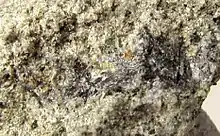Oosterboschite
Oosterboschite is a rare selenide mineral with the formula (Pd,Cu)7Se5.[1] It crystallises in the orthorhombic crystal system. It has a creamy yellow colour and a Moh's hardness of 5.[2] It is often found as grains with no clear shape.[3] The crystals are opaque and often no bigger than 0.4 mm.
| Oosterboschite | |
|---|---|
 Black Oosterboschite with trogtalite, cuprosklodowskite, and quartz from the Musonoi mine. From the Howard Belsky collection. | |
| General | |
| Category | Selenide minerals |
| Formula (repeating unit) | (Pd,Cu)7Se5 |
| Strunz classification | 2.BC.10 |
| Dana classification | 2.16.15.2 |
| Crystal system | Orthorhombic Unknown space group |
| Unit cell | a = 10.42, b = 10.6, c = 14.43, Z = 8 |
| Identification | |
| Colour | Creamy yellow-white |
| Crystal habit | Anhedral grains |
| Mohs scale hardness | 5 |
| Luster | Metallic |
| Streak | Black |
| Diaphaneity | Opaque |
| Density | 8.48 (calculated) |
| Ultraviolet fluorescence | None |
| Solubility | Insoluble |
| References | |
Occurrence
The mineral was approved by the IMA in 1970, after being discovered in the Musonoi Cu–Co mine, near Kolwezi, Katanga Province, Congo. It was later also discovered at the Copper Hills prospect, East Pilbara, Australia, and at Hope’s Nose, Torquay, Devon, England.[4] It is often found in the oxidation zones of the mines, together with verbeekite, trogtalite, selenian digenite, covellite, gold, and chrisstanleyite. It was named after Robert Oosterbosch, a Belgian mining engineer that was very active in the Katanga region, where the type locality is also located.[2]
References
- "Oosterboschite: Oosterboschite mineral information and data". www.mindat.org. Retrieved 2017-01-13.
- Zdenek Johan, Paul Picot, Roland Pierrot, Theodore Verbeek (1972). "Oosterboschite" (PDF). American Mineralogist. 57: 1553.CS1 maint: multiple names: authors list (link)
- Barthelmy, Dave. "Oosterboschite Mineral Data". www.webmineral.com. Retrieved 2017-01-13.
- "Oosterboschite" (PDF). Handbook of Mineralogy.
